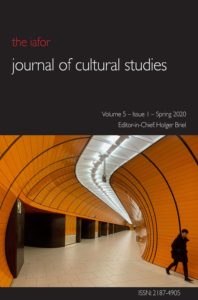Dear Readers,
Welcome to this issue of the IAFOR Journal of Cultural Studies, whose publication coincides with the outbreak of the Covid-19 virus.
At first, during late January and early February 2020, the world breathlessly stared at China, fascinated by the ill fate that had befallen its populace, deemed to be far removed from the West and containable on living room flat screens and mobile phones. At times, the virus outbreak was even used as an excuse for localised racism, as when a bus of Chinese was stoned in the Ukraine.
But by late February 2020, however, panic had set in in many parts of the world, as it became clear that, thanks to globalisation, China was everywhere and that dreams of racial and cultural differences, as fake news would have us believe, did protect neither Africans nor Europeans from the disease. Already within a single culture, individuals change the side of the street when another approaches; outbreaks are denied or designated as “negligible” or a return to normalcy by “this coming Saturday” (Irans president Hassan Rohani) is promised; whistleblowers are taken into police custody or the outbreak is used to showcase a government’s ability to build a new hospital within a week, relegating the outbreak to an economic problem that can be solved by real estate means; hoarding taking place in supermarkets, with prices of food rising by up to 20% month-on-month (China) or masks and disinfectant sold at exorbitant prices; and news outlets decrying the negative effect the virus has on the stock market or the output of companies rather than looking at the plight of the infected people.
At such a time, it is good to remember that culture, the relating of oneself to one’s own and to others’ social modes of behaviour, is never a state, but always a process; any “progress” is always under threat and can easily be reversed in times of crisis. The articles in this issue do not address the Covid-19 virus, as they were all written before the existence of this virus was known. But all of them do comment on it indirectly as they comment on political and cultural changes and challenges people face in different parts of the world, as they flag inequalities, attempts at rewriting history and undue pressure exerted by governments to regulate free artistic expression.
In this issue:
Article 1
The first article, Applying Burn’s Kineikonic Mode to a Dangdut Music Performance: Via Vallen’s Sayang at the 2018 Indonesian Choice Awards 5.0 NET by Alberta Natasia Adji analyses a specific Dangdut performance from 2018. Dangdut is a genre of Indonesian folk music with influences from Hindustani, Arabic, and Malay traditional music and generally associated with female singers revealing much naked skin during performances. It is also a staple of the working classes’ entertainment. Via Vallen, a rising star in Indonesian popular music, used this genre for her performance at the 2018 Choice Awards, but fused it further with K-pop elements and a very buttoned-up wardrobe choice. Alberta Adji analyses this performance via Burn’s Kineikonic methodology, effecting a visual close reading of the performance. She then contextualises her findings with recent politico-religious developments in Indonesian society, concluding with an analysis of the relationship between Indonesia’s compliant elites, sexism, religious extremism and working-class cultures.
https://doi.org/10.22492/ijcs.5.1.01
Article 2
If Adji’s text can be read as an aural sociogramme of Indonesia in the twentyteens, the second text in this issue, Michael Tsangaris and Konstantina Agrafioti’s Psychobilly Psychosis and The Garage Disease in Athens also deals with music, but this time as a counterculture movement in Greece. Over the last 30 years, Psychobilly music, tracing its heritage from rockabilly and punk, has been a counter-culture sound track to a lifestyle quite removed from the Greek mainstream and mainly acted out in Athens and Thessaloniki. Tsangaris and Agrafioti tell the story of this music genre, interview some of its leading actors and concisely comment on its resurgence as a mere lifestyle fad without deeper political implications.
https://doi.org/10.22492/ijcs.5.1.02
Article 3
Kenneth N. Hansen’s Uncivil Rights: The Abuse of Tribal Sovereignty and the Termination of American Indian Tribal Citizenship analyses the increasing number of tribal terminations of membership in California, tracing it back to legislation allowing tribes to run casinos and thus being afforded the opportunity to make a good living for the first time since their land had been stolen by white settlers. It is the irony of history that due to unregulated tribal governance, exclusion from a tribal register for financial gain of a few is now regularly taking place, thus replaying the disenfranchisement of the many as that of a few. What is so very striking in this is the complicity of the white majority, washing its hands of this practice via legislation claiming that all this is done legally by the minority to its own members.
https://doi.org/10.22492/ijcs.5.1.03
Article 4
Going a bit further back in time, “A New and Curious Route to Cairo” – World’s Fairs and the stereotyping of the Middle East (1851–1893) by Holly O’Farrell investigates a number of World’s Fairs in the second half of the 19th century and lays bare the reasons for their success. They were held, both in Europe and in the USA, to purportedly educate the public about far away cultures. The comparison to the rising popularity of zoos at the same time is not too farfetched, as practicing members of these “exotic”, mostly orientalised cultures were brought in to perform their culture to the delectation of Western audiences, who were given the opportunity to bask in the alleged superiority of their own civilisation over the exhibited ones. This, and it comes as no surprise, also involved the sexualised gaze when it came to the performance of belly dance spectacles, creating calculated scandals.
https://doi.org/10.22492/ijcs.5.1.04
Article 5
Lastly, Jamie N. Sanchez’ Repair: Mongolian Art as Reimagination of Pastoral Identity explores some of the cultural production of the Chinese province of Inner Mongolia during the ongoing Hanification of Mongolian society. Sanchez describes in detail how much of the traditional lifestyle of Mongolians is being eroded by engineered cultural changes and how some Mongolians artists are working at consciousness raising about this fact and how they are attempting to reverse such cultural engineering and reclaim their culture and traditional ways of life.
https://doi.org/10.22492/ijcs.5.1.05
Please stay healthy and we hope you enjoy this issue of the IAFOR Journal of Cultural Studies!
Holger Briel
Editor-in-Chief


